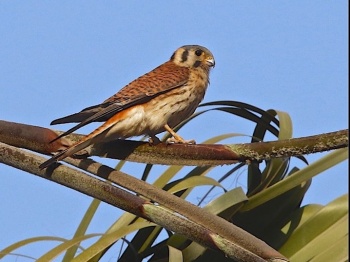- Falco sparverius
Identification
9-12" (23-30 cm). W. 21" (53 cm)
A jay-sized falcon, often seen hovering. Recognizable in all plumages by rusty tail and back.
Adult male has slate-blue wings but black-spotted rusty mantle and scapulars, which dominate the view from the back when perched.
Female has rusty wings and back, narrow bands on tail.
Both sexes have 2 black stripes on face.
Variation
In the Caribbean, both very dark and very pale forms occur.
Distribution

Photo © by Stanley Jones
Hotel El Angolo Chosica, Chosica, Lima, Peru, 15 August 2017
North America: widespread and very common, found from Alaska and Canada east to Nova Scotia and south to Mexico.
Central America and South America: found in most appropriate habitats south to Patagonia.
Caribbean: found almost everywhere except where it is or recently has been persecuted.
Northern populations are migratory, moving as far south as Panama.
Taxonomy
Subspecies
About 17 races are recognised[1]:
- F. s. sparverius: occurs in much of North America
- F. s. paulus: in the south-eastern United States
- F. s. peninsularis: in Baja California and western Mexico
- F. s. tropicalis: in southern Mexico, Guatemala and northern Honduras
- F. s. nicaraguensis: in north-west Honduras and Nicaragua
- F. s. ochraceus: in eastern Colombia and north-west Venezuela
- F. s. isabellinus: in the Guianas and east Venezuela
- F. s. aequatorialis: in north-west Colombia and north Ecuador
- F. s. caucae: Mountains of western Colombia
- F. s. peruvianus: in south-west Ecuador, Peru and north Chile
- F. s. cinnamominus: from south-east Peru to Tierra del Fuego
- F. s. fernandensis: on Masatierra and Juan Fernandez Islands
- F. s. cearae: in southern Brazil
- F. s. sparverioides: occurs in the southern Bahamas and Cuba
- F. s. dominicensis: in Hispaniola
- F. s. caribaearum: in Puerto Rico, the Virgin Islands and Lesser Antilles
- F. s. brevipennis: in the Netherlands Antilles
Habitat
Open forest and woodland, semi-desert, plains, grassland and cultivated land with scattered trees. In some areas a common urban bird.
Behaviour
Actions
Frequently hovers in mid-air while hunting.
Diet
Their main diet consists of insects and small invertebrates. The nominate subspecies mostly hunts for small rodents.
Breeding
This is a cavity nesting species. Clutch of 4-5 cream colored eggs with blotches and mottling.
Vocalisation
Shrill killy-killy-killy
Movements
Resident or sedentary over most of range. Race sparverius, from Alaska, Canada and northern USA migratory.
References
- Clements, J. F., T. S. Schulenberg, M. J. Iliff, S. M. Billerman, T. A. Fredericks, B. L. Sullivan, and C. L. Wood. 2019. The eBird/Clements Checklist of Birds of the World: v2019. Downloaded from http://www.birds.cornell.edu/clementschecklist/download/
- White, C.M., Kirwan, G.M., Christie, D.A. & Boesman, P. (2020). American Kestrel (Falco sparverius). In: del Hoyo, J., Elliott, A., Sargatal, J., Christie, D.A. & de Juana, E. (eds.). Handbook of the Birds of the World Alive. Lynx Edicions, Barcelona. (retrieved from https://www.hbw.com/node/53219 on 27 February 2020).
- BirdForum Member observations
- Smallwood, J. A. and D. M. Bird (2002). American Kestrel (Falco sparverius), version 2.0. In The Birds of North America (A. F. Poole and F. B. Gill, Editors). Cornell Lab of Ornithology, Ithaca, NY, USA. https://doi.org/10.2173/bna.602
- Global Raptor Information Network. 2020. Species account: American Kestrel Falco sparverius. Downloaded from http://www.globalraptors.org on 27 Feb. 2020
- Ely, T.E., et al. (2018). Morphological changes in American Kestrels at continental migration sites. Global Ecology and Conservation 15: e00400.
Recommended Citation
- BirdForum Opus contributors. (2025) American Kestrel. In: BirdForum, the forum for wild birds and birding. Retrieved 11 May 2025 from https://www.birdforum.net/opus/American_Kestrel
External Links
GSearch checked for 2020 platform.1






